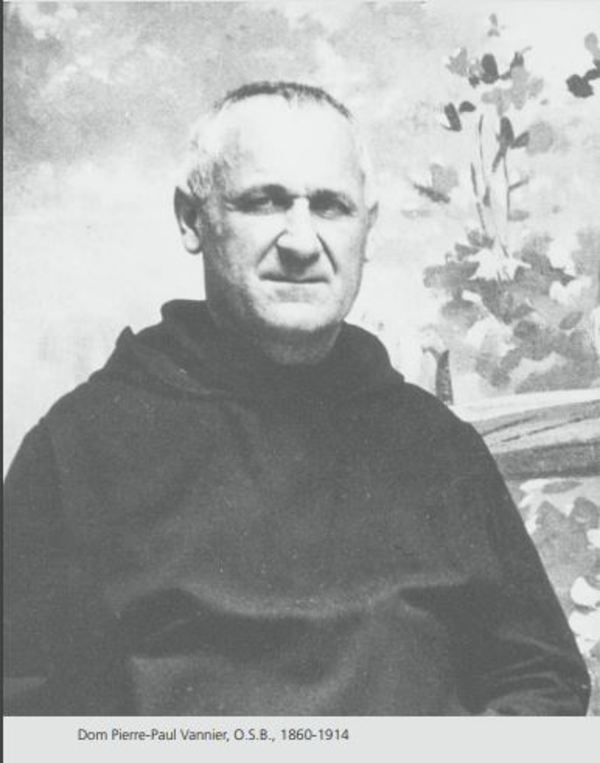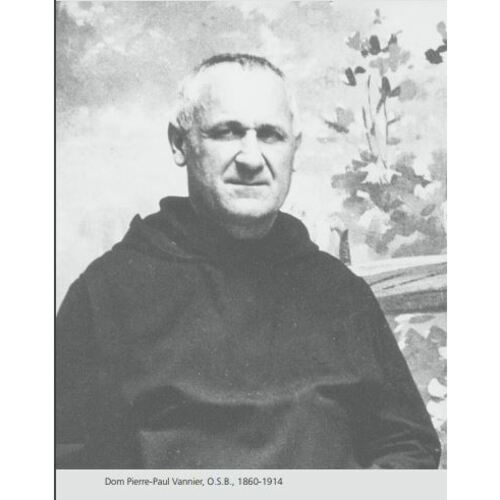
Source: Link
VANNIER, PIERRE-PAUL, Benedictine, founder and first superior of the abbey at Saint-Benoît-du-Lac, Que.; b. 16 March 1860 in Bauné, France, son of Pierre-Gaspard Vannier, steward of the castle of Briançon, and Anne Juteau; drowned 30 Nov. 1914 and was buried 2 December in Saint-Benoît-du-Lac.
After completing classical studies at the Collège de Combrée, in France, and spending a year at the Grand Séminaire d’Angers, Pierre-Paul Vannier entered the abbey of Saint-Pierre de Solesmes. There he took his vows in 1881 and was ordained to the priesthood in 1885. He became imbued with the spirit of the Benedictine congregation, founded in 1837 by Prosper Guéranger, and began learning Gregorian chant under Joseph Pothier. In 1890 he was one of a group put in charge of restoring the ancient abbey at Saint-Maur-sur-Loire; as the person responsible for food supplies there, tie greatly expanded the vineyards and orchards. The anti-religious laws of 1901 forced the monks of Saint-Maur-sur-Loire to emigrate to Belgium. Later they moved to the Grand Duchy of Luxembourg, where Vannier directed the construction of the beautiful abbey at Clervaux, and served as assistant prior and master of the lay brothers. An enterprising but thoughtful administrator, he occasionally antagonized those around him by his rather brusque manner. There would never be any doubt, however, as to his honesty, his religious spirit, his dedication, or his loyalty to his superiors. When he became involved in a quarrel between his abbot and an important person in the country, he secured permission to withdraw temporarily to another monastery in the interest of facilitating a reconciliation.
At the end of April 1911 Vannier joined the community of Saint-Wandrille, which was also in exile, at the castle of Dongelberg in Belgium. There he renewed his acquaintance with Dom Pothier, its abbot, and was immediately given responsibility for the lay brothers. Saint-Wandrille found it difficult to make a place and a future for itself in Belgium, where from 1901 hundreds of French communities had been crowding in, and since 1908 the prior, Paul Picard, had been preparing to set up a new refuge in Canada for his community. In 1910 Bishop Paul La Rocque* of Sherbrooke, Que., had indicated that he was willing to accept the monks into his diocese. However, the abbey not only lacked financial resources, but also had no one equal to the task of setting up a monastic colony with faith, competence, and fearlessness alone as support. The assignment was offered to Vannier and he accepted it. After a few months of preparation he boarded ship with just one companion, an ordinary lay postulant. Having arrived in Montreal on 5 July 1912, he went first to the Cistercian abbey at Oka to get advice from Pierre Oger, named Dom Marie-Antoine (a native, like himself, of Anjou), and then put himself at the disposal of the bishop of Sherbrooke. On 16 July he set out in search of a site for the future monastery.
The modest farm in Bolton Township, close to Lac Memphrémagog, where Saint-Benoit-du-Lac saw the light of day on 4 December, would be the centre of a mission that Bishop La Rocque had long envisioned for this spot. At the same time it would be a place of solitude for a community dedicated to prayer and the humble tasks of the cloister. The mission was supposed to be a temporary one. Vannier carried on his ministry zealously and soon attracted new families to the region. The Benedictine foundation began to make a name for itself. With the three lay postulants who were soon working with him, the priest at first eked out a living from the produce of the farm and the forest, repaired his dilapidated house, planted apple trees, and then applied to the mother abbey for the necessary assistance. Two monks were sent out to him in 1913 and two more came in 1914. The house was enlarged. But World War I cut off any further aid. On 30 Nov. 1914 Vannier and a brother monk set out for Sherbrooke to attend a celebration in honour of Bishop La Rocque, but they were drowned when their motor boat was punctured by a thin layer of ice formed at the northern end of Lac Memphrémagog.
Dom Pierre-Paul Vannier lived in Canada for just two and a half years and left behind only a frail organization, but others would keep his work alive during the war and expand it afterwards.
All of the major documents concerning Dom Pierre-Paul Vannier are preserved in the Arch. de l’Abbaye Saint-Benoît (Saint-Benoît-du-Lac, Qué.), sér.A. This material includes the journal which Vannier kept between 1912 and 1914 and originals or copies of several of his letters, as well as reminiscences of deceased relatives and copies of documents obtained from the archives of various abbeys, dioceses, and parishes. A history of the foundation of the abbey is provided in Abbaye Saint-Benoît-du-Lac (Pierre-Qui-Vire, France, 1962).
Cite This Article
Jean Rochon, “VANNIER, PIERRE-PAUL,” in Dictionary of Canadian Biography, vol. 14, University of Toronto/Université Laval, 2003–, accessed December 19, 2025, https://www.biographi.ca/en/bio/vannier_pierre_paul_14E.html.
The citation above shows the format for footnotes and endnotes according to the Chicago manual of style (16th edition). Information to be used in other citation formats:
| Permalink: | https://www.biographi.ca/en/bio/vannier_pierre_paul_14E.html |
| Author of Article: | Jean Rochon |
| Title of Article: | VANNIER, PIERRE-PAUL |
| Publication Name: | Dictionary of Canadian Biography, vol. 14 |
| Publisher: | University of Toronto/Université Laval |
| Year of publication: | 1998 |
| Year of revision: | 1998 |
| Access Date: | December 19, 2025 |



